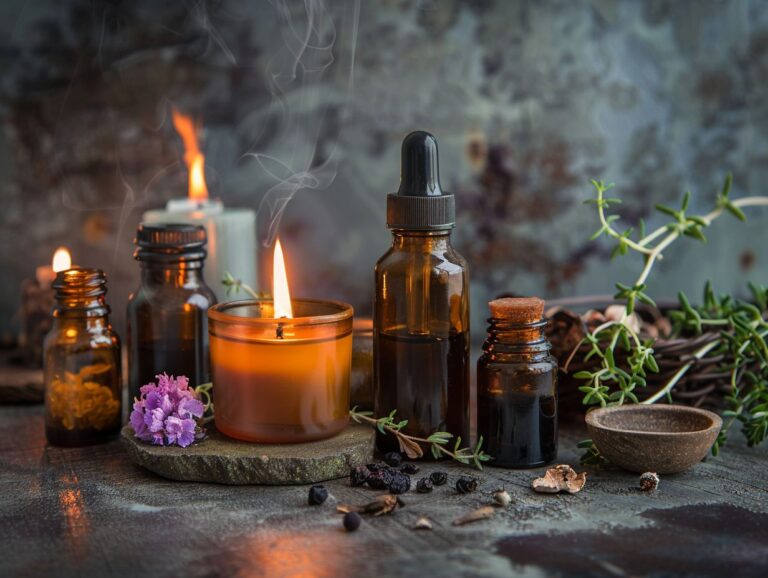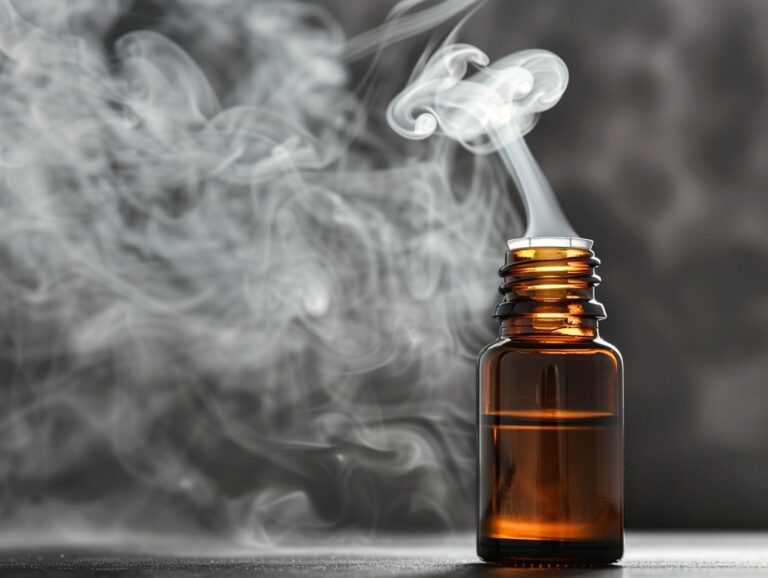How Do Essential Oils Work Topically
Essential oils have gained popularity for their various therapeutic benefits.
We will explore the science behind the topical application of essential oils, including how they penetrate the skin and the benefits they can provide.
Discover the best essential oils for topical use, safe ways to use them on children and pets, and common carrier oils for dilution.
Learn more about the different ways to use essential oils on your skin.
Key Takeaways:
What Are Essential Oils?
Essential oils are natural compounds extracted from plants that capture the plant’s scent and flavor or ‘essence.’ These oils are commonly used in aromatherapy to promote emotional and physical well-being.
The extraction process of essential oils involves various methods, such as steam distillation, cold pressing, or solvent extraction, depending on the plant source. Each method yields different types of oils with unique properties and benefits. For example, Lavender oil is known for its calming and soothing effects, while Tea Tree oil is prized for its antibacterial and antifungal properties. These oils can be incorporated into skincare routines to address various skin concerns or utilized in diffusers for aromatherapy purposes to reduce stress, improve sleep quality, and enhance overall mood.
What Are the Different Ways to Use Essential Oils?
Essential oils can be used in various ways, including topical application, inhalation, and ingestion, each method offering unique benefits depending on the desired outcome.
Regarding topical application, diluting essential oils with a carrier oil before applying them to the skin is crucial to prevent irritation. This method is effective for targeting specific areas for relief, such as sore muscles or promoting healthy skin.
- Inhalation
is another popular method that involves diffusing oils in the air or inhaling them directly. This approach can help with respiratory issues, stress relief, and mood enhancement. Safety precautions include using proper dilution ratios and avoiding prolonged exposure to strong scents.
How Do Essential Oils Work Topically?
When applied topically, essential oils are absorbed through the skin and can provide localized and systemic effects, impacting both physical and emotional well-being.
Essential oils possess unique molecular structures that allow them to penetrate the skin barrier efficiently. Upon application, these oils traverse through the epidermis into the dermis, where they can enter the bloodstream and lymphatic system.
Once in the bloodstream, essential oils are circulated throughout the body, reaching various organs and tissues. Their therapeutic properties influence different bodily systems, such as the respiratory, digestive, and nervous systems, promoting balance and well-being.
What Is the Science Behind Topical Application of Essential Oils?
The science behind the topical application of essential oils involves understanding how the compounds penetrate the skin layers, interact with receptors, and potentially trigger physiological responses.
Researchers at the University of Minnesota have delved into the intricate process where essential oil molecules permeate through the stratum corneum, the outermost layer of the skin, aided by their small molecular size and lipid-soluble nature. This allows them to reach deeper layers, where they may influence immune responses and modulate inflammatory pathways. Studies from institutions like Coursera have highlighted how specific essential oil constituents can bind to skin receptors, such as TRPV1, triggering sensory responses that can promote relaxation and pain relief.
How Do Essential Oils Penetrate the Skin?
Essential oils penetrate the skin through diffusion, where the oils travel through the epidermis and dermis layers to reach the bloodstream and lymphatic system, allowing for systemic effects.
This process of skin penetration by essential oils is highly influenced by various factors. Factors such as the molecular size of the oil, skin integrity, and the presence of carrier oils can impact absorption rates.
Once absorbed, these oils can travel through different pathways in the body, interacting with various systems. The olfactory pathway, for instance, involves inhalation, where the oils can directly affect the brain and emotions. On the other hand, topical application allows for localized effects as well as absorption into the bloodstream.
What Are the Benefits of Topical Use of Essential Oils?

Essential oils, derived from plants, are concentrated extracts that carry the therapeutic properties of the source plant. When applied topically, these oils penetrate the skin and enter the bloodstream, providing holistic benefits.
Peppermint oil can alleviate muscle tension, while lavender oil promotes calmness. Incorporating essential oils into skincare routines can improve the complexion, reduce inflammation, and eradicate acne. Notably, the aromatic molecules in the oils can influence emotions, aiding in stress relief and promoting mental well-being.
Are There Any Risks or Side Effects of Topical Use of Essential Oils?
While generally safe, topical use of essential oils can pose risks for individuals with sensitive skin or allergies, potentially causing skin reactions or irritations.
It’s crucial to always perform a patch test before applying undiluted essential oils to the skin, especially if you’re trying a new oil or product. This helps to assess for any adverse reactions or sensitivities. Diluting essential oils with a carrier oil is recommended to minimize the risk of skin irritation, as undiluted oils can be too potent and harsh on the skin.
Certain essential oils, like citrus oils, can increase sensitivity to sunlight, leading to sunburn or skin discoloration if not used cautiously. Be mindful of the phototoxic properties of these oils and avoid sun exposure after applying them to the skin.
What Are the Best Essential Oils for Topical Use?
Regarding the best essential oils for topical use, lavender, peppermint, and other popular choices stand out for their versatility and effectiveness in skincare, massage, and aromatherapy.
- Lavender oil is known for its calming properties, making it perfect for addressing stress and promoting relaxation when applied topically. Its soothing aroma and gentle nature make it suitable for various skin types, offering hydration and reducing inflammation.
- Peppermint oil has a refreshing scent and cooling sensation on the skin, making it ideal for muscle relief and tension reduction during massages. It can also help alleviate headaches when gently massaged onto the temples.
- Tea tree oil is renowned for its antibacterial and antifungal properties, making it a great choice for tackling acne and skin irritation. When diluted properly, it can be applied sparingly to blemishes or mixed in with a moisturizer.
- Frankincense oil is favored for its ability to promote skin rejuvenation and reduce the appearance of scars and fine lines. It can be used in DIY facial serums or added to body oils for a luxurious skincare experience.
- Rosemary oil is stimulating and can help improve circulation when included in massage blends. Its herbaceous aroma can also aid in mental clarity and focus, making it a versatile addition to your essential oil collection.
What Essential Oils Are Safe for Direct Skin Contact?
Certain essential oils like lavender, tea tree, and cedarwood are considered safe for direct skin contact and can be applied neat or diluted in body lotions for various benefits.
Another versatile essential oil safe for direct skin contact is peppermint, known for its cooling effect and ability to relieve headaches and muscle tension.
Frankincense, with its calming properties, is great for skincare and promoting relaxation when applied on the skin or in a massage oil.
Geranium is rejuvenating and helps balance the skin’s oil production, making it ideal for skincare routines.
- Chamomile is gentle and soothing, suitable for sensitive skin, and can be used to reduce inflammation.
- Rosemary is invigorating and may help improve circulation when applied topically.
Lastly, ylang ylang is prized for its aphrodisiac properties and is often used in perfumes or diffused for a romantic ambiance.
What Essential Oils Should Be Diluted Before Topical Use?
Essential oils that are particularly potent or have a high risk of skin irritation, such as cinnamon or oregano, should always be diluted with carrier oils before topical application to ensure safety and reduce the risk of adverse reactions.
Dilution is crucial as undiluted essential oils can be too harsh for direct skin contact and may lead to irritation, redness, or even burns.
Carrier oils serve as a safe medium to mix with essential oils, ensuring a gentler application. For example, oils like peppermint, clove, and thyme are highly concentrated and require dilution to prevent skin sensitization. The recommended dilution ratio for most essential oils is 2-3% in a carrier oil, which equates to about 6-9 drops of essential oil per ounce of carrier oil.
How to Use Essential Oils Topically?
Using essential oils topically involves applying the oils to specific areas of the body, such as the wrists, palms, or the bottom of the feet, depending on the desired effect or benefit.
When choosing the area for application, it’s crucial to consider the potency of the oil and its intended use. For example, lavender oil can be gently massaged onto the temples for relaxation, while peppermint oil is often applied to the chest for respiratory support. To enhance absorption, diluting essential oils with a carrier oil like coconut or almond oil is recommended. Using gentle, circular motions during application can also help improve circulation and skin absorption.
What Are Some Common Carrier Oils Used for Dilution?

Each carrier oil offers unique benefits due to its distinct composition. For instance, Fractionated Coconut Oil stands out for its long shelf life, feather-light texture, and odorless nature, making it an excellent choice for sensitive skin or those with nut allergies. On the other hand, V-6 Enhanced Vegetable Oil Complex is a blend of various carrier oils, providing a rich source of essential fatty acids that nourish and moisturize the skin deeply.
When selecting a carrier oil, consider your skin type and the intended use. Jojoba Oil, known for its resemblance to the skin’s natural oils, is ideal for acne-prone or oily skin due to its balancing properties. Conversely, Argan Oil is a great option for dry or aging skin, thanks to its high vitamin E and antioxidant content that promotes skin rejuvenation.
How to Perform a Patch Test for Skin Sensitivity?
Before widespread topical application, it is essential to conduct a patch test by applying a diluted essential oil to a small area on the abdomen or inner arm to check for any skin reactions or sensitivities.
Begin by choosing a small area of skin that is easily accessible and doesn’t have any pre-existing skin conditions. Cleanse the area with mild soap and water, ensuring it is completely dry before proceeding.
- Dilute the essential oil of your choice with a carrier oil at the recommended ratio.
- Apply a small amount of this diluted mixture to the designated skin area.
- Cover the spot with a bandage or gauze to prevent the oil from spreading.
Wait 24 hours and observe for any signs of irritation, redness, itching, or swelling. If no reaction occurs, the oil is likely safe for further use. If any adverse effects are noted, wash the area immediately and avoid using that essential oil in the future.
What Are Some Popular Topical Applications of Essential Oils?
Essential oils find popular topical applications in skincare routines, massage therapies, and oil blends, offering nourishment, relaxation, and rejuvenation when applied to specific areas like the face, fingers, or feet.
When used in skincare, essential oils such as lavender and tea tree can combat acne and promote a clear complexion, while oils like rosehip seed and frankincense can aid in reducing wrinkles and scars.
In massage therapy, the soothing properties of oils like chamomile and peppermint can ease muscle tension and alleviate stress, promoting a sense of calm and well-being.
Blending oils like eucalyptus, lemon, and rosemary can create invigorating mixtures for diffusers or topical application, perfect for boosting focus and energy during work or study.
Can Essential Oils Be Used Topically for Children and Pets?
It is crucial to exercise caution when using essential oils topically on children and pets, as their skin and sensitivity levels differ from adults, requiring special care and considerations in application.
When choosing essential oils for children and pets, it is important to opt for gentle, kid-friendly options such as lavender, chamomile, or tea tree. These oils are generally well-tolerated and offer various benefits without being too harsh on delicate skin.
Proper dilution is key when applying why essential oils work on young ones or furry friends. It is advisable to dilute one to three drops of essential oil in a carrier oil such as coconut or almond oil before use. This helps prevent skin irritation and ensures safe application.
Despite the many benefits of essential oils, certain oils can be harmful to children and pets if used incorrectly. Oils like eucalyptus, wintergreen, and cinnamon should be avoided, as they can cause adverse reactions. Always do a patch test and monitor for any negative effects when introducing new oils.
What Are Some Safety Precautions for Topical Use of Essential Oils on Children and Pets?
When using essential oils topically on children and pets, it is advisable to opt for specially formulated products like KidScents , Seedlings , and Animal Scents for safe and gentle application, ensuring the well-being of your loved ones.
It is crucial to follow proper dilution guidelines to minimize the risk of skin irritation or sensitivities. For children, it is recommended to dilute essential oils at a ratio of 0.25% to 1% in a carrier oil such as coconut or almond oil. As for pets, consult with a veterinarian or a professional aromatherapist for guidance on safe dilution ratios, as their skin sensitivity varies greatly depending on the species.
Always perform a patch test on a small area of the skin to check for any adverse reactions before applying essential oils more broadly. Keep essential oils out of reach of children to prevent accidental ingestion, which can be harmful. It is essential to store oils in dark-colored glass bottles in a cool, dry place away from direct sunlight to maintain their potency and quality.
Frequently Asked Questions
How Do Essential Oils Work Topically?

Essential oils are concentrated plant extracts that can be used for a variety of purposes, including topical application. But how exactly do they work when applied to the skin?
What is the mechanism of action for essential oils topically?
When applied topically, essential oils work by being absorbed through the skin and entering the bloodstream. From there, they can travel to different parts of the body and have a therapeutic effect.
Do essential oils need to be diluted before using topically?
It is recommended to dilute essential oils before applying them topically, especially if you have sensitive skin. This helps to prevent skin irritation and allows the oils to be more easily absorbed.
Can essential oils be used topically for pain relief?
Yes, some essential oils have analgesic properties and can be used topically to help alleviate pain. Examples include peppermint, lavender, and eucalyptus oils.
How long do essential oils take to work when applied topically?
The amount of time it takes for essential oils to work topically can vary depending on the individual and the specific oil being used. Some people may experience immediate relief, while others may take longer to feel the effects.
Are there any precautions to take when using essential oils topically?
Yes, it is important to always do a patch test before applying essential oils to a larger area of skin. Additionally, some essential oils may interact with certain medications, so it is important to consult with a healthcare professional before using them topically.







